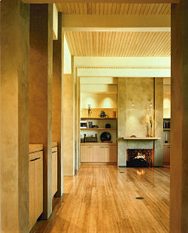What do you think about the durability of the pvac glue? Will it be as good as the pu-glue? Thanks for your information.
Blog Post
No-added-formaldehyde bamboo flooring and panel products

On the heels of the announcement of the market introduction of Smith & Fong's no-added-formaldehyde PlybooPure bamboo flooring and panel products in the current issue of Environmental Building News, Dan Smith of Smith & Fong — the makers of Plyboo, and more recently, Durapalm — along with PR guy John McIsaac (who used to be with Columbia Forest Products), were in our office yesterday morning to discuss the state of their art with some of the Environmental Building News and GreenSpec staff. The company's backstory is interesting: According to Smith (who incidentally has a degree in Mandarin Chinese), they started in 1989 out of a simple fascination with bamboo — it didn't really have anything to do with being green. They used Paul Hawken's book, Growing a Business (predecessor of The Ecology of Commerce), to guide their venture. Initially, they imported bamboo plywood to make decorative boxes "that nobody bought" (at first). The end of the lean years really started when the flooring thing came along in 1993. Consistently introducing new product lines and innovations since then, the company has grown by 25 to 40 percent per year since... with a rousing 70 percent increase in 2007. Unlike most bamboo flooring companies, Smith & Fong owns the facilities that produces their products, giving them quality control and R&D opportunities most of the rest of the industry doesn't have, and providing the ability to ensure safe and healthy conditions for the workers. They do not, however, own the land where the bamboo is harvested; the five-year-old poles are purchased from local stewards. (Land "ownership" in China is a tricky thing. Technically, the government owns it all — but individual people are assigned use-rights to individual tracts, which are inherited by successive generations.) The poles are harvested from natural groves by "farmers" — for want of a better word, since the bamboo isn't planted, irrigated, fertilized, or treated with pesticides — who selectively cull 20% of the age-commingled grove annually. So, every five years the natural supply has been 100% harvested without any clearcutting. The groves are admittedly a monoculture, albeit a natural monoculture. Which brings us full circle, back to PlybooPure. Smith & Fong have been using a 0.05ppm formaldehyde adhesive for their bamboo products — low, but not low enough to achieve the "no added urea-formaldehyde" LEED threshold. Finding a different binder that is cost-effective isn't simple. Formaldehyde resins are cheap and fast; other binders tend to cost more, and are typically slower-setting, which not only retards workflows, but can require changes in machinery and processes. Worker safety is wrapped up in this as well. They've worked out the bugs on an isocyanate binder, and now have no-added-formaldehyde flooring and panel product out the door and on the ground — which is just the beginning. Plans are to convert the entire production. (Their coconut palm products have used this non-formaldehyde adhesive all along.) For more about bamboo materials in general, see the March 2006 Environmental Building News feature, "Bamboo in Construction: Is the Grass Always Greener?"
Published January 16, 2008 Permalink Citation
(2008, January 16). No-added-formaldehyde bamboo flooring and panel products. Retrieved from https://www.buildinggreen.com/blog/no-added-formaldehyde-bamboo-flooring-and-panel-products
Comments
i am happy to be the first to
i am happy to be the first to comment here and i am starting research RE: green products w/o chemicals for our 2 bdrm condo in California. please feel free to send me info about this ;)
We used isocyanate binder to
We used isocyanate binder to produce bamboo floor in 1993, we finally abandoned this binder because there was an emission when the glue was heated for hardening, and the workers got uncomfortable when they smelled the odor. I don't know if isocyanate binder now is improved, we thought it was a toxic compound at that time, there was a death's-head sign on every package of this glue.
As I understood, Polyvinyl acetate (PVAc)(Vinyl Acetate Homopolymer) is a better glue to be used for making wood or bamboo products, we began using it to produce bamboo floor and bamboo plywood in 1995, we used PVAc from Henkel which the price was 10 times higher than common UF glue.



Add new comment
To post a comment, you need to register for a BuildingGreen Basic membership (free) or login to your existing profile.